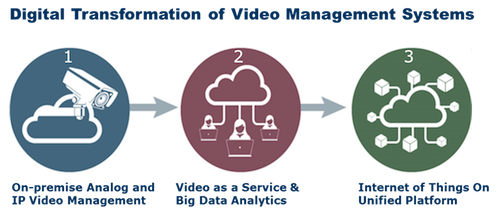
The time to reinvent your business is now. Clearly, cloud-driven digital transformation and Internet of Things (IoT) are emerging as major change drivers across entire industries like public safety, retail, transportation, hospitality, manufacturing etc. with massive implications on business models, workflow management, systems and people. As I had alluded to in my last posting “Everything Connected”, the innovation drive and opportunities are huge. Incremental updates on well-known frameworks will not be enough to maintain your competitiveness or even remain relevant in your market. This might be time for a big strategic change.
Explore the Major ”Blue Ocean” Innovation Opportunity
To take full advantage of new, cloud-based IoT opportunities, today’s companies must fundamentally rethink their approach to value creation and customer-centric offerings. I view the innovation effort and approach in cloud IoT as a major “blue ocean” market opportunity. The blue ocean strategy concept is all about leaving the bloody red ocean of rivals fighting over a shrinking profit pool, and venture into a new avenue of lasting success. And that increasingly comes, not from battling competitors, but from creating blue oceans of untapped new market spaces ripe for growth.
Your company could be the one to break the value-cost trade-offs, redefining your industry by eliminating the factors the industry has taken for granted but create no value for customers.
Imagine how you can design services and business models that introduce new factors never seen before. Or elevate the factors that truly create value beyond current standards. It’s for sure not easy to do, but if you are not doing it, someone else is probably doing it to you.
“Edison’s electric light did not come from the continuous improvement of candles…”
-Oren Harari
Reinvent Your Business Model with “Anything as a Service”
The Internet has enabled the “as a service” business model for IT infrastructure and software. The IoT enables “anything as a service” business models for all kinds of traditional products. As a result, companies are shifting from selling products to offering services-based subscriptions that create more value for customers.
Even your doctor can be a cloud service in the future. IBM is working on a way to make its Watson supercomputer a far more effective medical tool for flesh-and-blood doctors by analyzing medical imaging data to learn what a healthy set of insides looks like. If this data is merged with each patient’s medical records, it could mean faster and more effective treatment for serious conditions. On the same mission CognitiveScale is a cloud based startup in Austin, Texas, which is founded by some of the folks behind IBM’s Watson. They develop big data interpretation and machine learning systems for better decision-making. Last year the company launched a health-care group to apply its technology to managing data from patients with chronic conditions such as cancer and respiratory ailment.
This “blue ocean” innovation is just one part of the technology “waves” that can transform your company’s value proposition, technology strategy and operational process model.
Digital Transformation is the Enabler of Businesses
Digital transformation expands businesses. For example, today’s video security camera performs surveillance to prevent crime and provide evidence for investigation. In a cloud and “everything connected” enabled future, companies can scale much further into business optimization and value creation for customers. Beyond security.
Camera sensors can monitor activity like people, cars, situational awareness at multiple customer sites, aggregating data analytics not possible in today’s dispatched on-premise systems. Deep learning techniques can dramatically improve the video search experience in evidence handling, just like advanced behavioral analytics can enhance video surveillance to prevent incidents like terror attacks, city crime and public safety at events.
Makers of industrial equipment like, the redefined GE -The Digital Industrial Company, can shift from selling capital goods to selling their products as services. Sensor data will tell the manufacturer how much the machinery is used enabling the manufacturer to charge by usage. Service and maintenance could be bundled into the hourly rate and change the entire business model.
The service model also enables automatic upgrades of software in an “always on” scenario introducing design and optimization of new process flows where value is created for customers. This data will ultimately help the manufacturer, transportation, hospitality service provider or retailer save on cost of operations and increase revenue through cross-selling additional products and services.
How is this transformation going to play out? There is for sure a lot of uncertainty, and I see the IoT evolving in the way that many technology trends do: at present, we’re at the peak of hype, topping the ‘inflated expectations’ on the Gartner curve. We’re still a few years away from the IoT as a pragmatic, productive reality.
But the trend is clear. I want to illustrate how this could go down in the video surveillance world, where we see three phases of the digital transformation leading to the IoT with video management in a key role.
Digital Technology Waves – Ride It or Dive It?
The first wave is “On-premise Analog and IP Video Management”. Since the 1950’s the traditional analog CCTV video application, security cameras capture an analog video signal and transfer that signal over coax cable to the Digital Video Recorder (DVR). Then the IP video started to take over in the late 1990’s, with Milestone Systems as a pioneer, because of much better image quality and scalability in a distributed architecture. It has been a very slow market transition. Today the IP market has just surpassed the analog video equipment share with 60% IP vs. 40% analog. The trend toward IP dominance is clear, and in massive on-premise deployments, it’s expected to be the preferred solution in most industries for a long time.
The second wave is “Video Surveillance as a Service and Big Data Analytics”. This will accelerate the transition from the analog time. It centers on video cloud computing and the management of data aggregation and presentation of video analytics. In a recent market research paper from Forrester, 58% of the respondents says that “Customer Analytics” is the most important technology investment in the next 12 months, and 31% mention cloud as the preferred deployment option. This will happen in a big way with traditional analytics and machine learning aggregation like mentioned earlier.
The advantage and reason for accelerated market adoption is that the cloud infrastructure scales without limits across sites and geographies by enabling a distributed cloud interconnected systems that can ensure the right level of data on the edge as well as in the cloud. The limiting factors at this stage of evolution is of course bandwidth constraints and security concerns. Also the fact that even after enabling cloud integration for storing, archiving and processing of video sensor data, it can prove difficult to convert it into useful actionable intelligence.
But that is a challenge that currently is being taken up by many startups and established corporations in Silicon Valley and other tech hubs in the world. We see early adoptors ready to enter the enterprise segment with entire new blue ocean value propositions based on Video Surveillance as a Service (VSaaS).
The third wave of transformation is, “The IoT on Unified Platform”. At this stage we just add more IoT sensors to the cloud video management and provide a unified integration and presentation of data. This platform is the lead into a business optimization scenario where the video IoT create significant value for customers and expands market opportunities for systems integrators and manufacturers to provide better business optimization and customer-centric businesses.
Let the transformation begin
Those who understand IP, cloud and the digital transformation opportunities will be in demand for providing new game-changing services, installing and integrating IoT with video at the core to visualize, manage and verify it all. Just jump on the wave or start creating it yourselves. Then take the fast swim lane to market leadership.
About The Author
Lars Nordenlund Friis
Vice President, Incubation & Ventures
Milestone Systems
Twitter: lnordenlund


